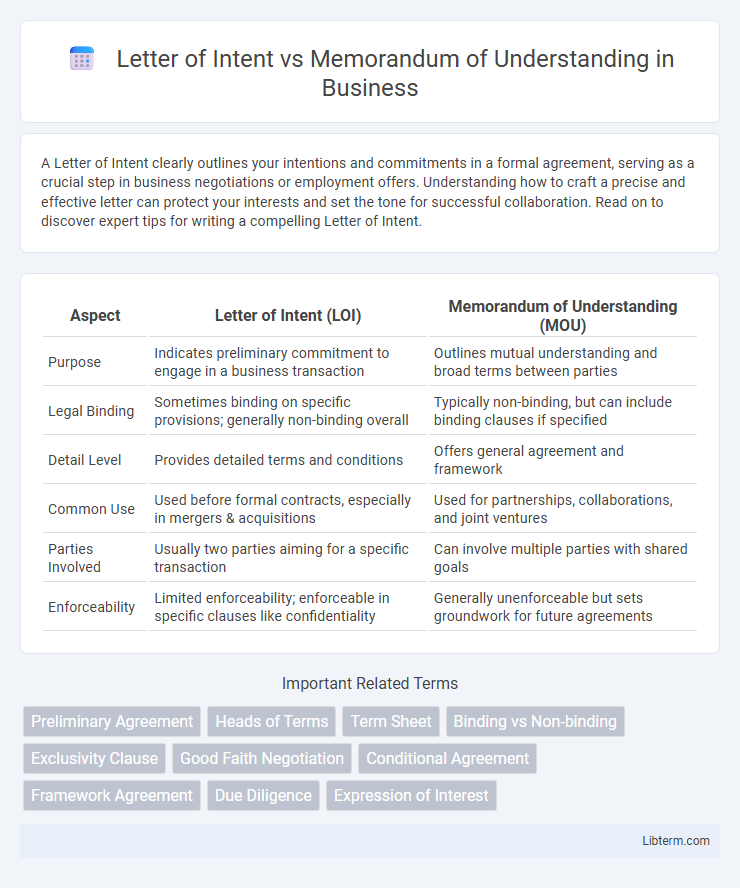A Letter of Intent clearly outlines your intentions and commitments in a formal agreement, serving as a crucial step in business negotiations or employment offers. Understanding how to craft a precise and effective letter can protect your interests and set the tone for successful collaboration. Read on to discover expert tips for writing a compelling Letter of Intent.
Table of Comparison
| Aspect | Letter of Intent (LOI) | Memorandum of Understanding (MOU) |
|---|---|---|
| Purpose | Indicates preliminary commitment to engage in a business transaction | Outlines mutual understanding and broad terms between parties |
| Legal Binding | Sometimes binding on specific provisions; generally non-binding overall | Typically non-binding, but can include binding clauses if specified |
| Detail Level | Provides detailed terms and conditions | Offers general agreement and framework |
| Common Use | Used before formal contracts, especially in mergers & acquisitions | Used for partnerships, collaborations, and joint ventures |
| Parties Involved | Usually two parties aiming for a specific transaction | Can involve multiple parties with shared goals |
| Enforceability | Limited enforceability; enforceable in specific clauses like confidentiality | Generally unenforceable but sets groundwork for future agreements |
Introduction to Letters of Intent and Memorandums of Understanding
Letters of Intent (LOIs) and Memorandums of Understanding (MOUs) serve as preliminary agreements outlining the intentions of parties before finalizing detailed contracts. LOIs typically express a party's desire to engage in negotiations or transactions, often emphasizing terms and conditions, while MOUs provide a broader framework for collaboration without the binding commitment. Both documents establish the foundation for mutual understanding and facilitate smoother negotiation processes in business, legal, and international relations contexts.
Defining the Letter of Intent (LOI)
A Letter of Intent (LOI) is a formal document outlining the preliminary understanding between parties before finalizing a contract or agreement. It typically details the key terms, intentions, and responsibilities to guide future negotiations without creating a legally binding commitment. LOIs serve as a foundation for more detailed agreements such as contracts or Memorandums of Understanding (MOUs).
Defining the Memorandum of Understanding (MOU)
A Memorandum of Understanding (MOU) is a formal agreement between two or more parties outlining mutual intentions and responsibilities without creating legally binding obligations. It serves as a framework for cooperation, detailing the scope, roles, and expectations to guide future contract negotiations. MOUs are commonly used in business partnerships, joint ventures, and international agreements to establish clear communication and shared goals.
Key Differences Between LOI and MOU
A Letter of Intent (LOI) primarily outlines preliminary agreement terms and expresses a party's intention to enter a formal contract, often binding key provisions such as confidentiality or exclusivity. In contrast, a Memorandum of Understanding (MOU) is a non-binding document that clarifies mutual understandings and outlines roles or responsibilities without imposing legal obligations. While LOIs are typically used in complex transactions like mergers and acquisitions, MOUs serve in partnerships or collaborations emphasizing cooperation rather than enforceability.
Legal Enforceability: LOI vs MOU
A Letter of Intent (LOI) often outlines preliminary terms and intentions without creating binding legal obligations, whereas a Memorandum of Understanding (MOU) can be legally enforceable depending on its language and jurisdiction. Courts typically examine the specific wording and intent of the parties to determine enforceability, with LOIs generally considered less formal and more flexible. Clear clauses about obligations, consideration, and dispute resolution increase the likelihood that an MOU will be recognized as a binding contract.
Common Use Cases for LOI
Letters of Intent (LOIs) are commonly used in mergers and acquisitions, real estate transactions, and joint ventures to outline preliminary terms before final agreements are drafted. LOIs establish the framework for negotiation, indicating the parties' commitment to proceed while allowing due diligence and detailed contract development. Unlike Memorandums of Understanding, LOIs often signal a stronger intent to transact and may include binding provisions such as exclusivity or confidentiality clauses.
Common Use Cases for MOU
A Memorandum of Understanding (MOU) is commonly used in business partnerships, joint ventures, and international agreements to outline preliminary terms and mutual intentions without creating legally binding obligations. MOUs serve as frameworks for collaboration, project planning, and resource sharing, facilitating clear communication and alignment between parties before formal contracts are drafted. Unlike Letters of Intent (LOIs) that often signal intent to proceed with transactions like mergers or acquisitions, MOUs emphasize cooperative efforts, research collaborations, and public-private partnerships.
Benefits and Limitations of LOI
A Letter of Intent (LOI) provides a clear, non-binding framework that outlines the preliminary understanding between parties, facilitating negotiation by identifying key terms and reducing misunderstandings. Its benefits include establishing intent and creating a roadmap for formal agreements without legal obligations, enhancing trust and transparency during early stages. Limitations of an LOI involve potential ambiguity and lack of enforceability, which may lead to disputes if parties interpret terms differently or fail to proceed toward a finalized contract.
Benefits and Limitations of MOU
A Memorandum of Understanding (MOU) clearly outlines the roles, responsibilities, and expectations of parties involved, facilitating smoother collaboration and reducing misunderstandings. Its non-binding nature allows flexibility and quick agreement without legal complications, which is beneficial for preliminary partnerships or projects. However, the lack of enforceability in MOUs can lead to uncertainty or disputes if parties fail to fulfill their commitments, limiting its effectiveness in formal or high-stakes agreements.
Choosing Between LOI and MOU: Which Is Right for Your Agreement?
Choosing between a Letter of Intent (LOI) and a Memorandum of Understanding (MOU) depends on the level of formality and binding intent required in your agreement. An LOI typically outlines preliminary terms and signals serious intent, often used in business transactions to facilitate negotiations, while an MOU provides a broader framework of mutual understanding without creating legal obligations. Assess your need for clarity on binding commitments versus a flexible agreement to determine which document aligns best with your strategic partnership or deal-making process.
Letter of Intent Infographic

 libterm.com
libterm.com